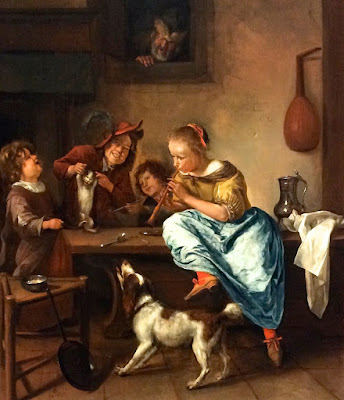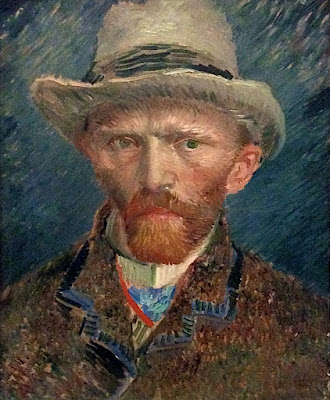The economy of the Netherlands was booming in the 1600s, and the good part was that the wealth was rather widely distributed. Instead of depending on the land and agriculture, the economy depended on commerce and manufacture. Thus, instead of the nation's wealth being hoarded by royalty and the landed aristocracy, it was accumulated by a fairly large class of merchants and traders. This had a good effect on art because a lot of people could afford to acquire or commission works of art. The burgeoning art market produced a star-studded array of artists, including Rembrandt and Vermeer, and encouraged the development of several popular genres.
Wealthy people are generally eager to have portraits painted of themselves and members of their family, and so most artists depended on portraiture for their bread and butter. Most people wanted sober, realistic, detailed portraits. While their outfits were not ostentatious, sitters showed off their wealth by wearing furs, lace, and other luxury materials, and artists displayed their skill by rendering them with touchable realism.
 |
| Frans Hals, c. 1582-1666 Portrait of Maritge Claesdr Vooght, 1639 |
 |
| Verspronck, c. 1600-1662 Portrait of Maria van Strijp, 1652 |
 |
| Rembrandt, 1606-1669 Portrait of a Woman, possibly Maria Trip, 1639 |
 |
| Werner van den Valckert, c. 1580-c. 1627 Portrait of a Goldsmith, 1617 |
This portrait of a couple is unique for its spontaneity and intimacy, as well as for its outdoor setting.
 |
| Frans Hals, c. 1582-1666 Portrait of a Couple, c. 1622 |
Artists practiced by painting each other. For this portrait of Rembrandt, with whom he shared a studio, Lievens imitated one of Rembrandt's styles; it looks like a self-portrait.
 |
| Jan Lievens, 1607-1674 Portrait of Rembrandt, c. 1628 |
If artists didn't have real clients to paint, they portrayed imaginary figures of certain types. The happy drinker was very popular.
 |
| Frans Hals, c. 1582-1666 c The Merry Drinker, 1630 |
Musicians were very popular. Notice that the market was large enough that there was room for a woman painter.
 |
| Judith Leyster, 1609-1660 The Serenade, 1629 |
The next painting combines the themes of painting and drinking. Who bought these paintings? Innkeepers? Notice the artist shows off his skill by painting the subject leaning toward the viewer with convincing depth of field.
 |
| Gerard van Honthorst, 1592-1656 The Merry Fiddler, 1623 |
Similarly, Vermeer liked to paint different types of women, sometimes wealthy women, sometimes servants, representing certain qualities. In the painting below, the maid must represent purity, and perhaps a sort of submission to duty.
 |
| Johannes Vermeer, 1632-1675 The Milkmaid, c. 1660 |
This desire for portraits expanded to include group portraits. It seems that every established organization of substance indulged in a group portrait. It was a challenge to make these groups look interesting, while rendering accurate portraits. The men in the painting below are the sampling officials of the draper's guild; they are looking at their sample book, which they used to check the quality of dyed cloth. They seem to have just looked up for a moment to greet a visitor. To add drama, Rembrandt painted their carpet-covered work table as though it were projecting toward the viewer. This should be a boring subject, but it is hard to look away from it.
 |
| Rembrandt, 1606-1669 The Syndics, The Sampling Officials of the Draper's Guild, 1662 |
Militia groups were especially keen on group portraits. The towns were walled, and each town had a militia group for security. Their principal duty was to guard the gates and patrol the streets at night. Membership was voluntary, and each man had to pay for his own gear, but it was considered a civic duty of young men of status, and service lasted only a few years. Graduation was marked by a banquet, and each graduating class wanted a group portrait to hang in the club's meeting hall, with each member paying a fee to be included, more for the prominent figures than for those in the background. This was another secure source of income for artists.
Because so many figures had to be included, these canvases tended to be very large. This one was about ten feet wide, so it was difficult to photograph. It is pretty typical of the genre. It was started by Frans Hals, but he got into a dispute with the guardsmen, so the seven figures on the right were painted by Pieter Codde. Notice that there is a certain uniformity in their garb, with sashes of different colors to mark rank or position, except that the leaders are wearing fancier get-ups.
 |
| Frans Hals & Pieter Codde The Meagre Company Militia Company of District XI , 1637 |
Here's a detail view of the left side, painted by Hals. Notice that the guardsmen are looking every which way, as though each one had posed individually without reference to the others. The composition is varied and rhythmic but not engaging.
 |
| Detail of The Meagre Company |
Instead of 'posing', these guardsmen are all engaged in the same activity, mustering for duty at the town gate. Instead of uniforms, they wear their own clothes, and it is difficult to distinguish them from the townspeople. Instead of each guardsman getting a yearbook-type portrait, their faces are submerged in the composition as a whole. Instead of a horizontal row, the figures are arranged with depth and forward movement.
 |
| Rembrandt, 1606-1669 The Night Watch, Militia Company of District II, 1642 |
Instead of being bluntly functional and realistic, Rembrandt threw in a fantasy figure. The golden girl with the chicken hanging from her belt symbolizes the attributes of the company. But who is the short figure beside her wearing a helmet with a garland? You can stand all day staring at this painting, wondering who is who and what is going on.
 |
| Detail of The Night Watch |
For decoration of their homes, wealthy townspeople liked landscapes.
 |
| Jacob Isaacksz van Ruisdael, c. 1628-1682 Landscape with Waterfall, c. 1660-1670 |
 |
| Meindert Hobbema, 1638-1709 A Watermill, c. 1664 |
There was also a big market for highly detailed still life paintings. Bouquets were popular, and they frequently included insects or small animals. This bouquet is a fantasy; the artist wouldn't have been able to get such a variety of blooms at the same time.
 |
| Balthasar van der Ast, c. 1593-1657 Still Life with Flowers, c. 1630 |
Many paintings depicted the aftermath of a sumptuous repast. Artists showed off their skill in rendering objects with touchable surfaces and true dimensionality. Notice that some of the plates are hanging off the edge of the table, projecting toward the viewer.
 |
| Willem Claesz Heda, 1594-1680 Still Life with a Gilt Cup, 1635 |
Several artists produced townscapes. This one by Vermeer is considered one of the greats.
 |
| Johannes Vermeer, 1632-1675 The Little Street, View of Houses in Delft, c. 1658 |
Life in town includes having a drink in the backyard of an inn.
 |
| Pieter de Hooch, 1629-c.1683 Figures in a Courtyard behind a House, 1665 |
Despite the nation's prosperity, beggars were a common sight. This painting depicts a self-satisfied businessman and his overdressed daughter contrasted with a beggar woman, accompanied by a poorly clad child, hovering hopefully. Do you think this guy is about to give a handout? He looks pretty stern.
 |
| Jan Steen, c. 1625-1679 d The Burgomaster of Delft and his Daughter, 1655 |
Paintings that documented the interior of picturesque or famous buildings allowed the artist to show off his ability to handle perspective.
 |
| Bartholomeus van Bassen & Esaias van de Velde Interior with a Company, 1622 |
 |
| Johannes Jelgerhuis, 1770-1836 The Shop of the Bookdealer Pieter Meijer Warnars, 1820 |
From all these sober pictures, you would never guess how much the Dutch like to party. Here's the gentry living it up.
 |
| Dirck Hals, 1591-1656 The Fête Champêtre, 1627 |
Here the peasants are having a festival.
 |
| David Teniers, 1610-1690 Country Festival, c. 1665 |
Here the kids are making up some amusement of their own. Notice the old guy in the window telling them to pipe down. The dog appears to be howling.
 |
| Jan Steen, c. 1625-1679 The Dancing Lesson, Children Teaching a Cat to Dance, c. 1679 |
The collection of the Rijksmuseum is pretty thorough on the big stars of the 1600s, like Rembrandt, Frans Hals, Vermeer, and Jan Steen, but for later centuries, it has a little of this and a little of that. The most impressive works from later centuries are a few paintings by van Gogh. Here's a stable and serene still life.
 |
| Vincent van Gogh, 1853-1890 Carafe and Dish with Citrus Fruit, 1887 |
Dynamic brushwork gives this self-portrait a penetrating quality.
 |
| Vincent van Gogh, 1853-1890 Self-portrait, 1887 |
The Rijksmuseum was closed for renovation from 2003 to 2012. We toured it just before they closed. We were interested to see how it had changed. The most delightful change was that instead of having blank white walls, the sumptuous 19th century decor had been restored.
Instead of building a new wing to house visitor services, as most museums have, the architect replaced two interior courtyards with a single atrium, a soaring light-filled space with a glass roof and polished stone floors.
We had lunch in their rather pretentious café, and later we had a latte and a pastry there, but we didn't have time for the large book store located under the café.






